SPECIFICATIONS
Torque Specifications

DESCRIPTION AND OPERATION
Information and Entertainment System
Component Location
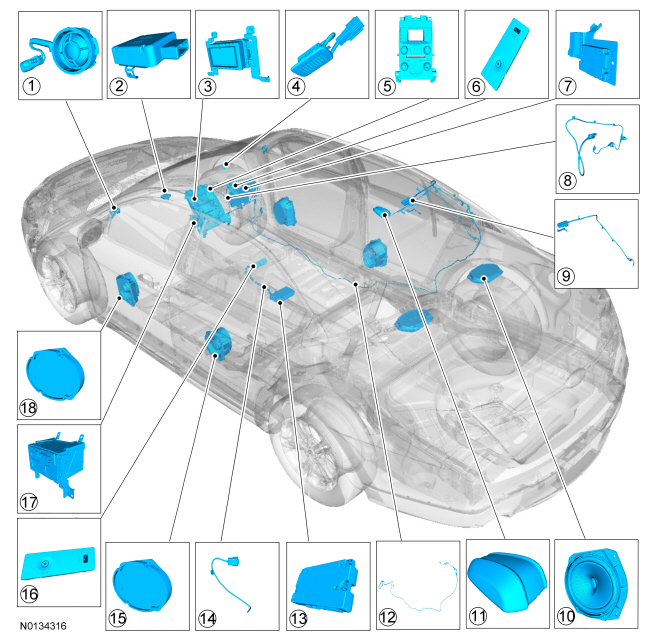
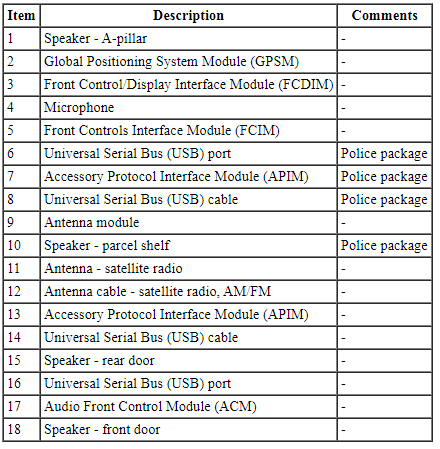
Overview
The audio system consist of a 4 (police package) or 6 speaker system, with an AM/FM single CD ACM, 4.2 inch non-touchscreen FCDIM, FCIM, audio input jack, steering wheel controls, SYNC APIM with USB port (if equipped) and optional satellite radio (not available on police package).
The SYNC system is a hands-free communication and entertainment system that provides the ability to:
- Send and receive phone calls via a Bluetooth-enabled paired phone
- Send and receive text messages via a Bluetooth-enabled paired phone
- Connect media devices (such as an iPod or USB device) in order to play audio files
- Play media files via a Bluetooth-enabled audio device
- Produce vehicle health reports
- Do not disturb feature
- Initiate an emergency call (eCall) when the air bags deploy
- Provide turn-by-turn traffic directions
Not all features are available with every phone.
Refer to the Owner's Literature for further information on SYNC.
System Operation
System Diagram
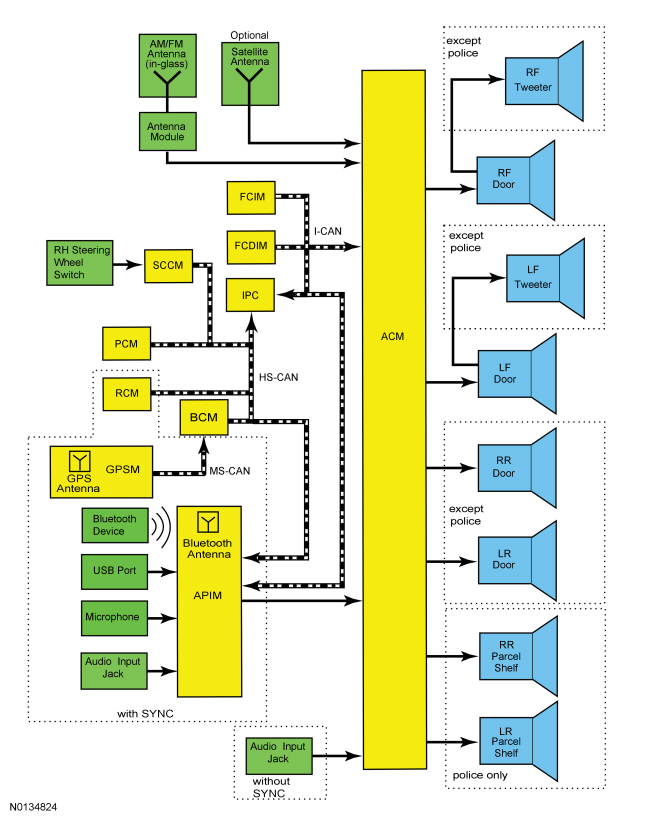
Network Message Chart
Module Network Input Messages - ACM
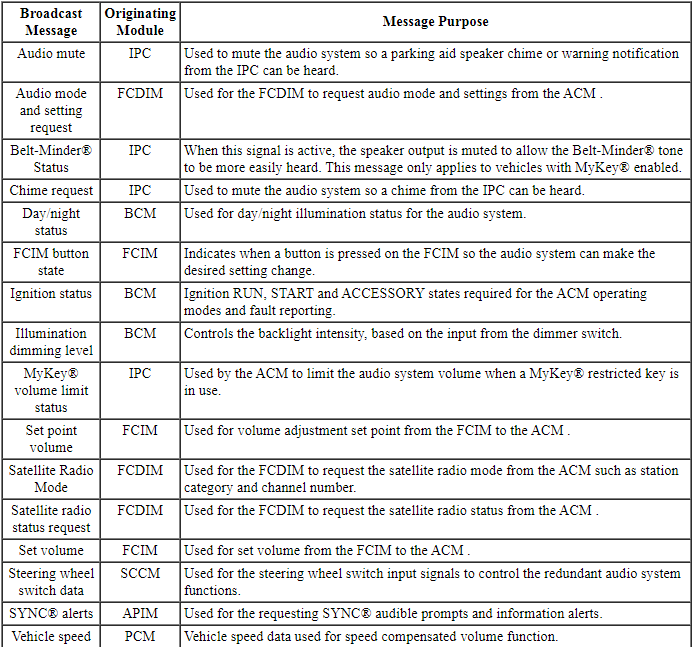

Module Network Input Messages - APIM
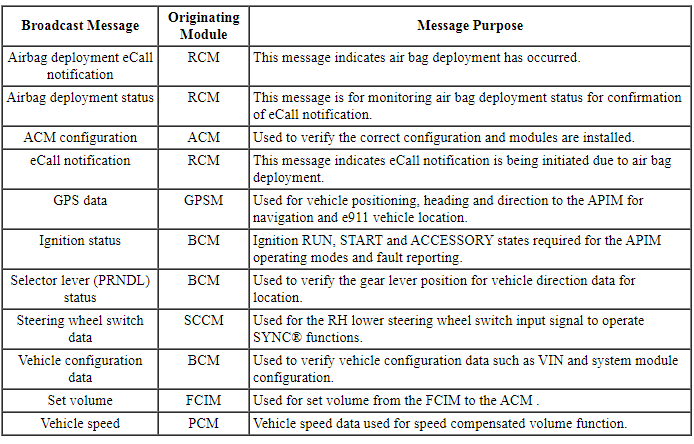
Module Network Input Messages - FCDIM
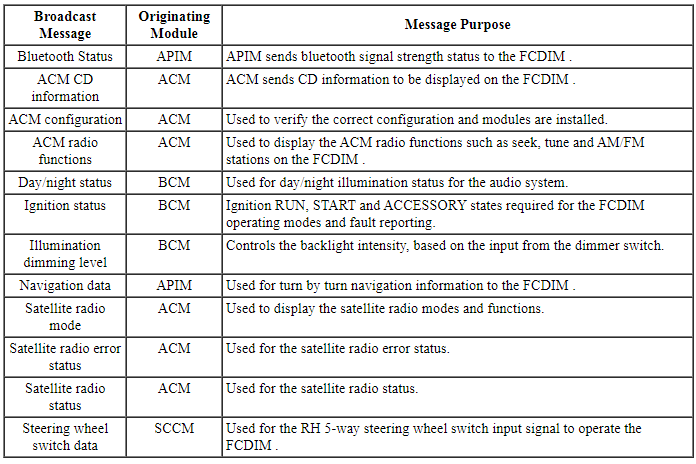
Module Network Input Messages - FCIM

Module Network Input Messages - GPSM

Module Network Input Messages - IPC

AM/FM Radio
The AM/FM antenna, integral to the rear window, receives AM and FM radio waves. The antenna module sends the radio waves to the ACM through the AM/FM antenna cable. The ACM converts the radio waves to a fluctuating AC output voltage to the system speakers. The ACM powers the AM/FM antenna to amplify the AM signal.
Satellite Radio
The satellite antenna receives digital signals and sends them to the ACM through the satellite radio antenna cable. The satellite radio receiver is built into the ACM.
Speed Compensated Volume
The ACM adjusts the audio system volume based on the VSS signal to compensate for speed and wind noise. Other modules also receive this signal and can exhibit symptoms if the signal is lost.
Audio Input Jack Mode
When a portable MP3 player is connected, audio from the MP3 player can be played through the vehicle speakers. When a device is connected through the audio input jack, only the speaker volume can be controlled by the vehicle audio system. All other functions (such as seek, fast forward, pause) must be carried out on the device itself. There are no external power or ground circuits to the audio input jack.
For vehicles without SYNC, audio signals are sent from the audio input jack to the ACM.
For vehicles with SYNC, audio signals are sent from the audio input jack to the APIM.
Steering Wheel Switch Function
The RH steering wheel switch consist of an integrated 5-way upper switch and 3 momentary toggle switches. The 5-way steering wheel switch operates the FCDIM display. The audio redundant controls are controlled by the 3 momentary toggle switches.
Voice Recognition
Voice recognition is used for many vehicle functions including audio system. The microphone relays the microphone input to the APIM through dedicated wiring. The TTS and voice prompt features speak certain text information and interaction requests to minimize driver distraction by having to look at the audio system display while driving. The ringtone alerts the driver to an incoming call. The microphone is also used to detect outgoing audio during a phone call.
Audible prompts can range from a simple tone to more elaborate spoken text, based on the customer setting. When interaction mode is set to standard, detailed guidance is provided. When interaction mode is set to advanced, most prompts are tones only and minimal audible guidance is provided. Refer to the Owner's Literature for further information on voice interaction.
The audio signals for the TTS and voice prompt features, the ringtones, and audio from the outside device during a phone call, are sent from the APIM to the ACM.
Bluetooth Mode
Bluetooth is a secure, short-range radio frequency that allows devices to communicate wirelessly through radio waves. The operating range of a Bluetooth signal is a maximum of 9.75 m (32 ft).
The Bluetooth interface can accommodate both Bluetooth-enabled mobile phones and Bluetooth-enabled media devices. The SYNC system allows interaction with several types of customer Bluetooth devices, including mobile phones and media devices. The APIM contains an on-board Bluetooth chipset, which enables certain wireless devices to interact with the system. Any Bluetooth device used with the SYNC system must first be paired with the system before it is operational.
Only one Bluetooth phone and one Bluetooth media device can be connected to the system at any one time. If an additional device of either type is paired with the system and made active, the APIM disconnects any active connection and establishes a connection with the new device.
When a new Bluetooth device is added, the APIM and the Bluetooth device must be paired together. Most Bluetooth devices can pair with the SYNC system, although functionality may vary. To determine if a Bluetooth device is supported, verify the customer device is on the compatibility list for the current APIM software level.
Pairing a Bluetooth device is accomplished through the "Add Device" selection of the phone menu. When pairing a device, the SYNC system generates a unique PIN that must be entered on the Bluetooth device in order for the pairing process to be successful. There are also some device-specific actions that must take place. For additional information on the pairing process, refer to the Owner's Literature.
It is important to understand that not all mobile phones have the same level of features when interacting with the SYNC system. For a list of compatible phones, refer to the SYNC MyRide website.
USB Audio Mode
The USB port can be used for connecting a media device (such as an iPod) with the device's available cable, or for directly plugging in a portable mass storage device (such as a "thumb drive"). When playing media files stored on a mass storage device, the SYNC system only plays files that do not have DRM protection. The USB port can also be used for uploading vehicle application upgrades. The USB port is powered by the APIM, so no external power source is needed to power a device plugged into the USB port if the device supports this feature.
In addition to audio information, metadata (information as artist, album title, song title, and genre) may also be sent to the APIM from a device plugged into the USB port. The APIM uses the metadata to create indexes that can be used to sort for particular music, based on customer preference. Not all USB devices can send metadata to the APIM. When a new media device is connected to the SYNC system, the APIM automatically indexes the information. This may take several minutes (depending on the amount of data on the device), and is considered normal operation. When a device that was previously connected to the SYNC system is reconnected, the APIM updates the index (rather than creating a new one), which reduces the amount of time needed to index the device.
Audible Prompts
The APIM receives both stereo and mono sound inputs, and can also transmit both stereo and mono sound. The mono function is used to receive the microphone input. It is also used to send sound to the ACM for voice prompts, the TTS feature, ringtones, and any audio received through a connected mobile phone. The TTS feature speaks information so that it does not have to be read from the display.
Battery Load Shed
The BCM uses the battery current sensor to keep track of the battery state of charge. The battery current sensor is a hall-effect sensor attached to the battery ground cable. When the engine is off, and the BCM determines the battery state of charge is below 40% or 10% of the charge has been drained or 45 minutes have elapsed, a load shed message is sent over the CAN. This message turns off the audio/navigation system to save the remaining battery charge. Under this condition, SYS OFF TO SAVE BATT is displayed on the centerstack infotainment display to notify the driver that battery protection actions are active.
Engine off load shed occurs when the engine is not running, and the ignition is in the ACC or RUN position. To clear the load shed state, restart the engine.
MyKey Audio Operation
When a MyKey is in use:
- the audio system is muted whenever the Belt-Minder is activated until the safety belts are buckled
- the satellite radio adult content stations are restricted
- if always on is selected in the MyKey menu then the 911 assist and do not disturb feature are enabled and cannot be disable
The MyKey also has an optional setting that limits the audio system volume. The maximum volume of the audio system is limited to 45%. In an attempt to exceed the limited volume, the MyKey VOLUME LIMITED message is displayed in the centerstack infotainment display. The speed compensated volume feature will be disabled.
Refer to the Owner's Literature for further information on MyKey.
Audio Extended Play
The audio extended play is a feature that enables the audio system after the ignition is OFF and any door has been opened. When the power button on the FCIM is pressed, the audio system functionality is restored and remains active for a period of 20-60 minutes, depending on configuration settings. To turn the audio system OFF, the power button on the FCIM is pressed. The audio extended play is disabled if the battery saver function is enabled.
SYNC Traffic, Directions and Information
The SYNC traffic, directions and information service is a subscription-based service that includes precise turn-by-turn directions, personalized real-time traffic updates with text alerts, business search, entertainment, news, sports, stocks, travel and weather. The customers mobile phone is used to access and download the SYNC services. The GPS antenna, that is integral to the GPSM, is used to detect the location and direction of the vehicle. For traffic, directions and information services subscription, refer to the SYNC MyRide website.
Component Description
Accessory Protocol Interface Module (APIM)
The APIM consists of 2 internal modules: the CIP and the VIP. These modules are not replaceable individually, but can be flashed independently, if required.
The CIP interfaces with all of the inputs to the APIM. It contains an analog-to-digital-to analog converter, as well as the Bluetooth chipset. Any application upgrades that are available to the consumer are loaded directly to the CIP through the USB port.
The VIP provides an interface between the CIP and the vehicle. Its main functions are controlling the APIM power management and translating both inbound and outbound signals. In addition, the VIP queries the modules on the network to retrieve any DTCs when a vehicle health report is requested.
Antenna
The AM/FM antenna is integral to the rear window and has an integrated antenna module that is powered by the ACM to improve AM/FM reception. If the vehicle is equipped with satellite radio, the satellite antenna is integrated into the roof-mounted antenna module.
Audio Front Control Module (ACM)
The ACM can be operated with the ignition in RUN or ACC. The accessory delay feature allows the audio system to be operated for a preset period of time after the ignition is turned off and a front door has not been opened. The ACM requires PMI when it is replaced.
Audio Input Jack
The audio input jack allows for a portable MP3 player to be connected to the vehicle audio system utilizing a 1/8-inch audio jack.
Front Control/Display Interface Module (FCDIM)
The FCDIM is a stand-alone module that displays infotainment system information. Information from the audio system and the climate control system are shown on the FCDIM display screen. The FCDIM requires PMI when it is replaced.
Front Controls Interface Module (FCIM)
The FCIM is one of the customer interfaces to the audio system. The FCIM is also the customer interface with the HVAC module. It is separate from the ACM.
Global Positioning System Module (GPSM)
The GPSM provides vehicle location for real-time traffic reports and re-routing, and for identifying vehicle location in the event of a collision. The GPSM requires PMI when it is replaced.
Microphone
The microphone receives the voice command and sends a signal to the APIM. The microphone is also used to detect outgoing audio during a phone call and voice commands for the SYNC system.
Steering Wheel Switches
The RH steering wheel switch consists of a series of resistors. Each steering wheel control switch function corresponds with a specific resistance value within the switch. The SCCM sends out a 5-volt reference voltage to the RH steering wheel switch on the input circuits and monitors the voltage drop when a button is pressed. The voltage drop varies depending upon the resistance of the specific button pressed, providing indication to the SCCM which switch is pressed.
USB Port
The USB port is connected to the APIM through the USB cable. The USB port can be used to play audio files or upload software from mass storage devices, or for connecting a media device.
 Diagnosis and Testing
Diagnosis and Testing
Information and Entertainment System
Special Tool(s)
Preliminary Inspection
Before diagnosing or repairing the audio system, verify the audio system
module(s) pass the network test.
DTC Chart(s)
...
Other materials:
Front Suspension
SPECIFICATIONS
Material
Torque Specifications
a Refer to the procedure in this section.
DESCRIPTION AND OPERATION
Front Suspension
The front suspension consists of the following components:
Wheel bearing and wheel hubs
Wheel studs
Lower arms
Stabilizer bar
Stabilizer bar links
Struts
...
Appendices
GENERAL INFORMATION
SYNC® End User License Agreement (EULA)
• You have acquired a device (“DEVICE”) that includes software
licensed by Ford Motor Company and its affiliates (“FORD MOTOR
COMPANY”) from an affiliate of Microsoft Corporation (“MS”). Those
installed software products ...
Specifications, Description and Operation, Diagnosis and Testing
SPECIFICATIONS
Material
General Specifications
Torque Specifications
a Refer to the procedure in this section.
b 15 Nm plus an additional 60 degrees
c 8 Nm plus an additional 180 degrees
DESCRIPTION AND OPERATION
Engine
Overview
The 2.0L GTDI 4-cylinder engine has ...

